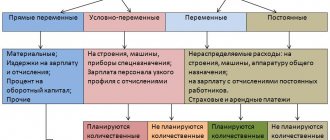How to get property
Simplified companies and individual entrepreneurs usually do not have sufficient working capital to immediately acquire ownership of the necessary property. Then organizations that provide property for leasing can help with this.
Subclause 4 of clause 1 of Article 346.16 of the Tax Code of the Russian Federation directly allows for the reduction of the single tax at the expense of leasing expenses under the simplified tax system. Namely, for the corresponding payments under the agreement for the acceptance of property on a leasing basis. They do this on the date that was later:
- day of transfer of payment;
- the last day of the month for which the payment is due.
VAT on leasing payments and redemption value is taken into account in costs along with the payments to which it relates.
Leasing, rent and loan: what is the difference
Equipment rental is also a solution to the problem. But there are disadvantages: you won't be able to charge depreciation on the rental property, and you won't own the equipment itself.
Another way out is lending. But loan terms are often prohibitive for small businesses.
Leasing is a hybrid of lending and renting. It is given on more favorable terms than a loan. As with rent, you will pay for the use of the property, but these payments will help you gradually buy the property. You will also accrue depreciation as you use it if the asset is on your balance sheet.
Accounting
Let’s look at what basic entries need to be made for leasing under the simplified tax system “income minus expenses.”
| OS received on lease: postings | ||
| № | Situation | How to proceed |
| 1 | Under the leasing agreement, the operating system does not immediately become the property of the simplifier | It must be reflected in off-balance sheet account 001 “Leased fixed assets” at the cost according to the agreement. The posting is as follows: Dt 001 – AMOUNT – the leased item is accepted for accounting. |
| 2 | The OS becomes the property of the simplifier | General OS rules apply |
The leasing payments themselves may appear in accounting:
- In expenses for ordinary activities (when the property is involved in the main production).
- In other costs (when the property is not involved in the main production).
| Leasing payments: postings | |
| Wiring | Content |
| Dt 20 (91) subaccount “Other expenses” – Kt 60 (76) subaccount “Settlements for the use of the leased asset” | Calculation of lease payment |
| Dt 60 (76) subaccount “Payments for the use of the leased asset” – Kt 51 | The lease payment is transferred (posting is done on the date of payment) |
For advances on lease payments, the entries will be as follows:
| Wiring | Content |
| Dt 60 (76) subaccount “Settlements for advances issued” – Kt 51 | Transfer of leasing payment in advance |
| Dt 20 (23, 25, 29, 44, 91 subaccount “Other expenses”) - Kt 60 (76) subaccount “Payments for the use of the leased asset” | Calculation of leasing payment (done monthly) |
| Dt 60 (76) subaccount “Settlements for the use of the leased asset” – K. 60 (76) subaccount “Settlements for advances issued” | Offsetting part of the advance or the entire advance against the debt to the lessor |
Features of leasing when simplified “Income” and “Income-expenses”
The simplified tax system of 6% involves only accounting for income. When you receive an asset, no income is generated, and you do not keep track of expenses. This means you cannot write off payments under a leasing agreement as expenses. If you intend to lease assets, then it is better to use the simplified “Income minus expenses”.
If the simplified tax system is 15%, take into account leasing payments in expenses at the time of payment. Make sure that payments under the leasing agreement are not advance payments, as they cannot be written off as expenses. Advances arise in two cases:
- the leasing agreement stipulates that payments are made to pay off the redemption price;
- you make current payments earlier than the deadline specified in the agreement.
Write off advance payments as expenses when ownership of the asset is transferred to you.
https://www.youtube.com/watch?v=user0283oksana
Important! If the transferred asset is on your balance sheet, keep track of the residual value of your fixed assets - 150 million rubles. If you exceed the limit, you will lose the right to use the simplified tax system.
Receiving a car
Let us explain the tax accounting of one of the most popular transactions in this area – car leasing under the simplified tax system “income minus expenses”.
The redemption price is the simplified cost of purchasing the OS. You can include it as expenses only in the year when the car finally becomes the property of the simplified tax system. And during the year, such costs are written off in equal parts according to reporting periods. At the same time, they begin to do this from the one in which the car was purchased.
As for lease payments directly, they are taken into account when they were transferred.
An advance payment of the total leasing price cannot be immediately reflected in accounting. It is included in expenses gradually according to the number of months as it goes towards periodic payments.
Next, let’s look at an example of leasing under the simplified tax system “income minus expenses”.
EXAMPLE
Guru LLC applies the simplified tax system with the object “income minus expenses”. In September 2021, the company received a car under a leasing agreement. The contract period is 3 years. The total amount of payments under the agreement is 5,500,000 rubles. The company transfers an advance to the lessor in the amount of 1,750,000 rubles. Of this, 55,000 rubles go towards the redemption price. The rest of the advance is counted towards monthly payments.
Guru LLC makes monthly payments from October 2021 to September 2021 in the amount of 151,250 rubles. Of them:
- 104,167 rubles – transferred in cash;
- 47,083 rubles - counted towards advance payment.
When calculating the single tax on the simplified tax system, the company recognizes as expenses:
- monthly from October 2021 to September 2021 - leasing payment in the amount of 151,250 rubles;
- as of September 30, 2019 - part of the redemption price in the amount of RUB 27,500. (RUB 55,000 / 2);
- as of November 30, 2019 - part of the redemption price in the amount of RUB 27,500.
This example demonstrates very well how to take into account leasing costs under the simplified tax system. There are practically no special rules. After all:
- leasing fee is an analogue of rental payments;
- redemption price – the cost of purchasing a fixed asset.
Otherwise, accountants know that advances cannot be expensed until they are offset against goods supplied or services rendered. Therefore, leasing on the simplified tax system “income minus expenses”, if there are advances, is posted in the Book of Income and Expenses according to the number of months the contract is valid.
Also see “Manipulations with loans under the simplified tax system “income minus expenses”.
Read also
17.04.2017
Accounting
Alekseeva Alena
We purchase a truck under a leasing agreement, which is recorded on our balance sheet. Under the terms of the agreement, the lessor insures the car and includes the costs of CASCO insurance in the amount of lease payments (this can be seen from the transcript provided by the lessor). Can we formulate the initial cost of a car in accounting, taking into account CASCO?
: Yes. At the moment you receive the leased asset, you have a fixed asset in your accounting. It must be included in its initial cost for accounting purposes. 8 Instructions, approved. By Order of the Ministry of Finance dated February 17, 1997 No. 15 (hereinafter referred to as the Directives); pp. 7, 8 PBU 6/01:
- the total price of the leasing agreement, that is, all expected payments under the leasing agreement (including the redemption price and CASCO insurance costs) p. 1 tbsp. 28 of the Law of October 29, 1998 No. 164-FZ;
- other expenses associated with the acquisition of the leased asset (for example, delivery costs and other related expenses).
As you can see, the amount of expenses under the CASCO insurance contract will automatically be included in the “accounting” initial cost of the leased car.
Vladislav Egorov, Moscow
Our organization received equipment on lease in May, and lease payments began to be made from that month. The term of the leasing agreement is 3 years, the right of redemption is provided, the equipment is taken into account on our balance sheet. Now it is accounted for on account 08 and is not yet ready for operation due to the fact that the construction of the structure in which it is supposed to be used has not yet been completed. What is the procedure for assigning leasing payments to expenses in accounting? At what point can we take them into account - before putting the equipment into operation or after?
: In accounting, the leased asset, recorded on the balance sheet of the lessee, is a fixed asset. Upon receipt, you made an entry to the debit of account 08 “Investments in non-current assets” and the credit of account 76 “Settlements with various debtors and creditors”, subaccount “Rental obligations”. This posting should have been made for the entire amount of payments under the contract minus VAT. 7, 8 PBU 6/01; clause 8 of the Instructions; clause 3 PBU 10/99.
The cost of fixed assets is transferred to expenses through depreciation. It is this that will be recognized as an expense in accounting. 2 tbsp. 31 of the Law of October 29, 1998 No. 164-FZ; clause 17 PBU 6/01; pp. 9, 50 Guidelines, approved. By Order of the Ministry of Finance dated October 13, 2003 No. 91n.
The accrual of leasing payments is reflected in Dt account 76, subaccount “Lease obligations”, in correspondence with Kt account 76, subaccount “Debt on leasing payments” p. 9 Guidelines. Consequently, if during the validity period of the leasing agreement its terms do not change, then leasing payments as an independent expense will not appear in accounting at all.
Stepanikova Irina, St. Petersburg
The organization applies the simplified tax system. Under a leasing agreement concluded for 3 years, we purchased an expensive car, which is recorded on our balance sheet. How long should we set its useful life in accounting for the purpose of calculating depreciation?
: In accounting, you must set the useful life of any fixed asset, including those received under a leasing agreement, based on the period of time during which you expect to use this OS. 20 PBU 6/01.
If, after completion of the leasing agreement, you do not repurchase the leased asset or, after repurchase, immediately plan to sell it, then the useful life of the leased property may be equal to the term of the leasing agreement.
If you are buying a car and plan to use it after the lease agreement ends, set a longer useful life for it.
We invite you to read: CASCO insurance in Rosgosstrakh in 2021
Income tax
Evgenia, accountant, Moscow
According to the terms of the leasing agreement, we, as the lessee, must pay for CASCO insurance. Moreover, the beneficiary of such insurance is not us, but the lessor. Can we take insurance costs into account as our expenses in tax accounting? If so, how?
https://www.youtube.com/watch?v=ytcreatorsru
: Yes, you can take into account the costs of such insurance - the Tax Code does not prevent this. 3 p. 1 art. 263, paragraph 6 of Art. 272 of the Tax Code of the Russian Federation.
However, keep in mind that there is one Letter from the Ministry of Finance (albeit two years ago), which says that the lessee can take into account payments under the insurance contract for the leased asset as expenses only if he is the beneficiary. Letter from the Ministry of Finance dated 08/09/2011 No. 03- 07-11/215. However, this approach is quite strange, because, as a rule, under the terms of leasing agreements:
- the amount of insurance compensation that the lessor receives from the insurance company reduces the lessee's debt in the event of theft or destruction of the car;
- If the amount of insurance received by the lessor is greater than the lessee's debt under the agreement, then the lessor must transfer the difference to the lessee.
Therefore, the lessee also benefits from car insurance. And such expenses are quite reasonable. 1 tbsp. 252 of the Tax Code of the Russian Federation. Experts from the Ministry of Finance also agree with this point of view.
FROM AUTHENTIC SOURCES
BAKHVALOVA Alexandra Sergeevna
Consultant of the Department of Tax and Customs Tariff Policy of the Ministry of Finance of Russia
“The Tax Code does not contain restrictions regarding who should be the beneficiary under an insurance contract for property leased.
In addition, as a rule, the lessee has a direct economic interest in ensuring that the leased asset (for example, a car) is insured, even if the lessee is not a beneficiary under the insurance agreement. After all, if the car is not insured, then severe damage, theft or loss of the car for other reasons can lead to significant financial losses for the lessee. Consequently, the costs of such an insurance contract comply with the provisions of Art. 252 of the Tax Code and they can be taken into account when calculating income tax.”
Moreover, you can take into account the costs of purchasing an insurance policy regardless of who has the leased car on their balance sheet: you (the lessee) or the lessor. Letter from the Ministry of Finance dated February 20, 2008 No. 03-03-06/1/119.
Inna Pogalova, Krasnogorsk, Moscow region.
We use a simplification with the “income” object; on the balance sheet we have vehicles purchased on lease. What are the features in determining the value of fixed assets leased during the transition to a general taxation system?
: Since you account for leased vehicles off the balance sheet, this means that under the terms of the leasing agreement they are taken into account on the lessor’s balance sheet. Therefore, when switching to the general tax regime, you will not need to depreciate these fixed assets. Therefore, regardless of whether you are on the “income” or “income-expenditure” simplification, when switching to the general regime you will not have to wonder about determining the residual value of leased fixed assets.
After the transition to a general taxation system, you will be able to recognize leasing payments as expenses, sub. 10 p. 1 art. 264 Tax Code of the Russian Federation. Of course, only those that you will have to pay according to the schedule after you say goodbye to the simplified payment.
Ekaterina, Moscow
We leased a car. Under the terms of the leasing agreement, the lessee must insure the car (MTPL, CASCO). Our organization is the beneficiary in the event that the car is completely destroyed or damaged beyond repair. And if the insurance compensation we receive is greater than the amount of the lessee’s total debt under the agreement, then we must transfer the difference to the lessee. The car was in an accident beyond repair. How should the received insurance be taken into account in tax income - in full or minus the amount due to the lessee?
We invite you to read: What is Casco Pro?
: Your company must include the entire amount of insurance compensation in non-operating income. 3 tbsp. 250 Tax Code of the Russian Federation.
But you can take into account the amount that you must transfer to the lessee in your expenses. 1 tbsp. 252 of the Tax Code of the Russian Federation. The Ministry of Finance also agrees with this. Letters of the Ministry of Finance dated March 18, 2013 No. 03-03-06/1/8154, dated July 17, 2012 No. 03-03-06/1/337.
So, in the end, the income tax base will be increased by the difference between the amount of insurance received and the part of it that you transfer to the lessee.
Kostina Elizaveta, Tver
Our organization is a lessor. According to the agreement, the leased asset is on our balance sheet. This OS refers to objects that have high energy efficiency in accordance with the government list. Also, this fixed asset does not belong to depreciation groups 1–3. Can we simultaneously apply two increasing factors to the depreciation rate: both leasing (not higher than 3) and “energy efficient” (not higher than 2)? That is, can we write off the cost of leasing OS 6 times faster?
: If you don’t want to argue with inspectors, then it’s better not to do this.
The Tax Code says nothing about the possibility (or impossibility) of simultaneous application of various increasing coefficients to the depreciation rate. 259.3 Tax Code of the Russian Federation.
However, the Ministry of Finance explained that it is impossible to apply two increasing coefficients simultaneously. Letter of the Ministry of Finance dated September 14, 2012 No. 03-03-06/1/481. His argument is this: the possibility of simultaneous application of several increasing factors to the depreciation rate of Ch. 25 of the Tax Code of the Russian Federation is not provided for. And if an organization has grounds for using several ratios, then it is necessary to establish in its accounting policy which one will be applied.
It is more profitable for you to use the leasing coefficient.
Saraeva Marina, Vladivostok
In 2009, our organization leased a vessel to another Russian organization under a leasing agreement. It is on our balance sheet, and since June 2009 it has been registered in the Russian International Register of Ships (RMRS). Used for short-sea flights (points of departure and destination are within Russia). Amendments were made to the Tax Code according to which, starting from 2012, depreciation on such vessels is not accrued. Can we continue to charge depreciation on this vessel, since we started charging it in 2009?
: The question is controversial. There are two positions on it (by the way, both of them were voiced by the Ministry of Finance).
POSITION 1. Now it is impossible to charge depreciation in relation to all vessels registered in the RMRS. Moreover, regardless of the purposes for which they are used. 3 tbsp. 256 Tax Code of the Russian Federation; Letters of the Ministry of Finance dated 02/11/2013 No. 03-03-06/4/3350, dated 06/13/2012 No. 03-03-06/1/305.
In addition, when calculating the income tax base, it is impossible to take into account other expenses associated with the maintenance and operation of a vessel registered in the Russian Marine Register. 48.5 Art. 270 Tax Code of the Russian Federation.
POSITION 2. If the vessel is used for coastal voyages, then income and expenses related to its use (even if it is registered in the RMRS) are taken into account when determining the income tax base. Letter of the Ministry of Finance dated June 22, 2012 No. 03-03-06/1/ 319.








